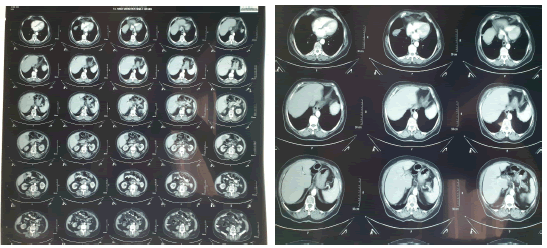Case Report - (2023) Volume 9, Issue 2
This case is the presentation of complete and definitive disappearance of a liver metastasis in colon cancer of a woman of 77 years old, with a long time chemotherapy.
Turnover time • Colon • Cellular kinetic
Primary peritoneal carcinoma is a rare intra-abdominal carcinomatosis, Colon and rectum cancer are among the most common cancers with increase of incidence. Unfortunately a lot of these patients will develop distant metastasis sometimes during the course of their illness. In this cancer is used a therapy following the turnover time and cellular kinetic [1-3]. The turnover time of the normal cells of the colon can change between 39 hours and 48 hours, in the cancerous cells is about 8 hours [4, 5]. Using a chemotherapy with low dose and continuous on a long time during all phases of the following mitosis there is the apoptosis of the cancer cells [6, 7].
The administration is done with seven days’ infuser 0,5 ml/hour with Fluorouracil (200 mg/sqm) a day for seven days. Folinic acid left handed form(175 mg) in bolus every seven days. This therapy is administered for three times in succession. After three weeks of infusion Oxaliplatin (dose 80 mg/sqm in 250 ml of glucose 5%) is administered. The period of suspension is 21 days/28 days but may be longer until the patient is in good conditions. Before starting every cycle leukocyte, platelets, liver, kidney and cardiac functions are evaluated.
A woman of 77 years old with sigma’s adenocarcinoma. First step surgery was performed with the left hemicolectomy PET 5/5/2009 liver metastasis 4 segment (suv 4,00), ultrasonography: liver 6/7/2009 hyperechoic area 15 mm faded edges margins vascular signal positive at power doppler. The patient started chemotherapy with infusion for five cycles of three weeks. Disappearance of liver metastasis in ultrasonography of April 2010 and TAC of October 2010. The follow up is negative not reappeared of liver metastasis in the life of the patient.
The chemotherapy intravenous on a long time with administration of low doses hit cells of cancer thought all the phases of cellular cycles and for more consecutive cell cycles with a decrease of toxicity of drugs [8, 9]. It is so possible to give the drugs during the hours most biologically favorable to kill neoplastic cells [10, 11]. With this method, three liver metastasis with 3 cm of diameter can be definitively destroyed, in neoadjuvant chemotherapy of transverse colon with two cycles. I had complete disappearance of primitive neoplastic ulcer, in colon descending mucinous adenocarcinoma with peritoneal ascites. I had complete disappearance of the ascites and the patient survived 8 years after the diagnosis (Figures 1-6).
Figure 1: Computed tomography scan of liver metastasis.
Figure 2: Left hemicolectomy PET 5/5/2009 liver metastasis 4 segment.
Figure 3: Ultrasound of Liver after chemotherapy without the metastasis
Figure 4: CT scan of liver metastasis.
Figure 5: Axial images of a patient with liver cancer.

Figure 6: Computerized axial tomography of liver on 22/10/2010
This therapy shows better results other than standard chemotherapy.
[Google Scholar ] [Crossref ]
[Google Scholar ] [Crossref ]
[Google Scholar ] [Crossref ]
[Google Scholar ] [Crossref ]
[Google Scholar] [Crossref ]
[Google Scholar ] [Crossref ]
[Google Scholar] [Crossref ]
[Google Scholar ] [Crossref ]
Citation: Russo, A. Prolonged Infusional Chemotherapy in Colon Cancer. Oncol Cancer Case Rep. 2023, 9(2), 1-2
Received: 10-Feb-2023, Manuscript No. OCCRS-23-89213; Editor assigned: 16-Feb-2023, Pre QC No. OCCRS-23-89213 (PQ); Reviewed: 17-Feb-2023, QC No. OCCRS-23-89213 (Q); Revised: 20-Feb-2023, Manuscript No. OCCRS- 23-89213 (R); Published: 30-Mar-2023, DOI: 10.35248/23.9.2.1-2
Copyright: ©2023 Russo, A This is an open-access article distributed under the terms of the Creative Commons Attribution License CC-BY, which permits unrestricted use, distribution, and reproduction in any medium, provided the original author and source are credited.